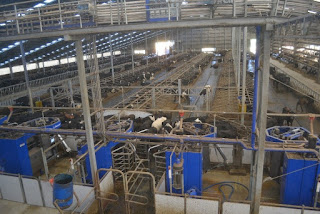 |
| Beautiful
sunrise at the Lindis Pass. |
While leaving Twizel this morning we drove past a salmon
farming operation. We traveled through mountains and foothills in the southern
edge of the McKenzie country. Once we reached the highpoint in Lindis Pass, we
stopped at a scenic overlook where we got to watch the sun rise over the
mountains.
 |
| Merino
Sheep crossing the road in front of the bus. |
We continued through the high country where merino sheep typically
graze, but currently are on paddocks closer to home since the winter season is
approaching. As we continued to drive through the lower edge of the high
country, we encountered a large flock of merino sheep being moved to a
different paddock using a paved highway. It seemed to be a common thing here,
but not something typically seen in the United States. Once we passed the flock
of sheep, we drove by multiple vineyards and wineries that are best known for
their Pinot Noir variety of wine. On our way to the small town of Cromwell, we
drove around the edge of Lake Dunstan. Upon arrival in Cromwell, we made a
quick stop for coffee and pastries.
 |
| Driving
around Lake Dunstan, near Cromwell |
 |
| Alistair
Campbell showing our group a map of his expansive property. |
Once we had finished our coffee and
pastries, we loaded in the bus and headed for the Earnscleugh Station managed
by Alistair Campbell’s son and located in the high country. Earnscleugh Station
is a massive operation consisting of 27,000 merino sheep, and 1,200 head of
beef cattle, consisting mostly of Angus and Hereford breeds. His property
spanned a massive 21,000 Hectares, approximately just over 50,000 acres. His
station is in an area that would be considered a continental climate. Average rainfall
numbers in the wetter areas reach up to 25-30 inches, and, in the less
productive more arid areas, rain numbers may be as low as 12 inches. As
elevation increases on the station, paddock sizes increase because the
productivity of the land decreases. Alistair’s son employs 3 full time shepherds,
1 man for maintenance, and 1 full time employee for rabbit control. Last year alone, they spent $70,000 on rabbit
control. Wild rabbits are a major issue in large ranching operations in the
high country of the South Island. They decimate the crop ground, and at one
point almost ran the station out of business in the mid-80’s. Wool production
on Earnscleugh Station is primarily focused on producing Ultra-fine and
Super-fine merino wool, used primarily in high end wool goods like suits. Each
year the total cost involving shearing and moving sheep totals a whopping
$250,000.
 |
| Up
close photo of a staple of 12.9 micron wool. |
 |
| Photo
of a few merino fleeces including the 12.9 micron fleece; we were able to
handle the
fleeces and see just how high quality merino wool is. |
 |
| Shearing
stations at the Earnscleugh Station. |
 |
| Wool
bags filled with merino wool ready for export. |
The majority of his flock produces wool of the super-fine variety,
which is approximately 15 microns, and a smaller proportion of his flock
produces an extremely desirable fleece consisting of ultra-fine wool close to
12-13 microns. The ultra-fine fetches a large price of around $200/kg while the
super-fine wool is >$50/kg depending on fiber diameter. The quality of the
wool dictates where the wool is exported to, and what its final purpose will
be. The purpose of the cattle on his operation is simply to keep the paddocks
groomed for the sheep, as the income from the beef cattle is minimal when
compared to the merino operation. Cattle in the high country need to be more
moderate and easy fleshing to be efficient and profitable in the dry
conditions. On Earnscleugh Station, Alistair’s duties are more focused on
seedstock improvement in both the cattle and the sheep.
 |
| Got to enjoy this scenic view at Queenstown while waiting for
the bus. |
After a long and
educational visit with Alistair Campbell, we departed the station and headed to
Queenstown, and, along the way, we drove through Alexandra, the Kawerau Gorge,
and Lake Hayes. Once we arrived in Queenstown, we had a couple of free hours to
get lunch and walk around to explore the city and take in the breathtaking
views. Queenstown is a beautiful city built around a lake, and is surrounded by
mountains and large hills. It is generally referred to as the adventure capital
of New Zealand. We ended the day driving alongside Lake Wakatipu and heading
into the southland. Our destination for the night will be Te Anau, where we
will spend the next two nights.
Dathan & Naomi













Comments
Post a Comment